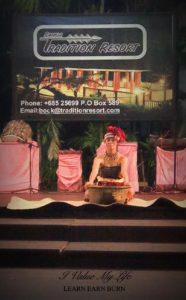
Culture and food never fail to acquaint me to a remarkable holiday trip. Early this year, I got hold of both in just one sitting. In revisiting my better half’s hometown, we got invited at the Samoa Tradition Resort. I delighted in people eating fire and I got to taste the authentic palusami and oka.
Samoa Tradition Resort, situated at Ululoloa, Apia, Upolu, Samoa, offers different types of accommodation.
Executive suites, apartments, villas and hotel rooms are available. Booking, by choice, comes with a tropical breakfast, transportation for hire and airport transfers. Add a free Fia Fia Night to that if you book their hottest apartment deal now at NZD341. (Offer good at the time of writing.)

If you are bound to Samoa, include a Fia Fia Night in your itinerary. Samoan Tradition Resort offers this every Thursday over buffet dinner. Loaded with the rich delicacies of Samoa, Chief Toomalatai and his crew provides a show. A show that walks you through a journey of not only the Samoan traditions, but also of the other Polynesian islands. Read on to know what to expect of a Fia Fia Night.
“Fiafia“, amongst the Pacific islands, is a word used to denote “happy”. Across Polynesia, it extends its meaning to “celebration,” “get-together,” or “an assembly”.
– Wikipedia
In the Samoan culture, a Fia Fia night reflects its culture of gathering in a celebration of songs and dances. These “happy people” proudly share their traditional ways. They entertain guests from all over the world over a buffet of authentic Polynesian cuisine.
It was my first time to experience the Fia Fia Night during my last visit and boy! Was I glad that I experienced it at the Samoa Tradition Resort!
Not only was the place big, the food great, but it featured an array of cultural songs and dances from across the Polynesia. I was just expecting a Samoan dance but they also included some from Tonga, Fiji and New Zealand.
THE PERFORMANCE IS DIVIDED INTO 3 ACTS.

Act 1: THE ‘AVA CEREMONY
The ‘Ava ceremony precedes special occasions in the Samoan culture. Most commonly, it is part of the fonos (meeting of political heads), malagas (welcoming traveling groups), bestowing of the blessings to the matai (chiefly title), village holiday, celebrations of any kind and after burial. It involves serving of the drink squeezed from the kava roots.
The glottal stop as you pronounce ‘Ava serves as the missing “K” which cognate both terms in the truest sense of how Polynesians understand kava. – The Religious Meaning of the Kava Ceremony, Anthropos, 1995 (Journal Article)
The tanoa (sacred bowl) collects the squeezed and chewed juice of the kava roots as the Samoans consider kava as a holy plant. The taupou mixes it with water after fermenting it by saliva. From then, the taupou starts to stir the mixture with the hibiscus bark.
The root particles become entangled by the fiberbundle. It is wringed again and again until the color turns brownish in color. The process is taboo to many. But this is a tradition practiced for almost 2,000 years already that it is honorable to become a part of.
The two occasions that made me personally witness an ‘Ava Ceremony.
One was way back 2011. Men in my husband’s family (he has 9 brothers), complete with uncles and chieves, gathered and did an ‘Ava Ceremony in honour of his pe’a tattooing.
Second, a more intense one. It was when he was blessed to be ali’i (high-chief). At that time, the ceremony lasted longer and it followed 6 strict steps. It involved praises, speeches, singing and many more. Rituals followed a certain pattern and it involved numerous matais (chieves).

Chief Poloma Toomalatai, a tulafale (talking chief, also known as an orator, second to the highest chief, the ali’i), opens the Fia Fia Night at the Samoa Tradition Resort with an ‘Ava Ceremony.
All in all, the show gives the audience a feel of how it’s officially and properly done. While the taupou prepares the kava and the fiberbundle is supposed to be clearing the drink of any residue, she remains focused. She looks straight ahead as she throws the fiberbundle over her shoulder. The young man who is supposed to catch it is to feel honoured and lucky to do so without letting the fiberbundle touch the floor.
When the kava is ready to be served, the distributor gives it to the important guests first. Since my husband is an ali’i, he was first addressed and was given the drink ahead of everybody. Observing the way the distributor gave the kava within the assigned cup (usually half of a coconut shell), his ways remained very traditional. His stance was politely upright, yet humbly serving, with the practice of keeping the outside part of the hand away from the ali’i‘s vision.
Walking from the right side of the tanoa bowl, he followed a series of steps in giving the drink. My husband, Masoe Hogan, responds by spilling a bit of the kava over his shoulder. This was a gesture that meant offering a drink to the Gods first before he drinks some.

Act 2: THE PRESENTATION OF CULTURAL DANCES
The group’s representation of many cultural orientations and performances were remarkable. Its sequence eases you to the Polynesian culture with awe and amazement. The dancers’ costumes and surreal portrayal took me at the edge of my seat.



My first time.
I learned with the segment about Maoris that because they are protective of their land, they always want to know your intention in visiting their territory. What they do is they lay a leaf in front of a traveler. If you come in peace, you pick up the leaf. But they have this intimidating look and projection that could send you retreating. My husband asked me to pick up the leaf as soon as possible before they think I come in bad faith.

Upon reaching New Zealand, local Māori people greets Prince Harry with the traditional warrior dance when he visited this month. They laid a leaf and then the prince picked it up while keeping eye contact with their leader. This expressed good intentions in visiting their country in behalf of the prince’s home. The maoris greeted and welcomed them then after with a hongi.
A hongi is the traditional Māori greeting where they press their nose and forehead to the guests. People believe that this gesture is based on a folklore when gods had breathed life to humans.
Many islands across the globe celebrate the Polynesian Dance as an art form.
Hula dance, automatically, comes in our minds when we talk about Polynesian Dance. Hula, which is the Hawaiian term meaning “dance”, is usually characterised by slow and graceful hip movements. It is originally from the island of Hawaii. This you can see performed at the Samoa Tradition Resort along many more dances from Fiji and Tonga.


The fast drum beats will surely set vibrating energy from the stage to the audience. Chief Toomalatai sings and chants as he leads the dancing group through this performances.
This versatile trait is one of the many lessons he imparts to his cast being triple threats. He plays the guitar, plays the drums and teaches fire-knife dancers. He owns the Toomalatai Dancing Group that produced fire-knife champions. By the name of Falaniko Solomona and Hogan Toomalatai. Not to mention, Pasikale Toomalatai, his son who had won champion of the junior division this year at the 17th International Siva Afi Competition.
What a total performer!
The youngsters play the drums and other instruments. The guitars, Tahitian Mahogany There Drums, ukulele and some bass drums to name a few.
Undeniably, the most exciting of all is the Siva Afi or the fire-knife dance. The warrior weapon, traditionally known as the nifo’oti, is twirled and spun. Similar to a warrior club, this nifo’oti, has a knife at one end with a hook covered in material and bound by wire for it to be lighted up with fire.

During the ancient years, Samoa used this in defending their territory from foreign invaders and conquerors. Nowadays, it had turned to be a sport. Slowly, it became part of the performing arts and was a strong representation of the Samoan culture. It also became a form of entertainment for tourists and visitors from overseas.
Don’t worry, Samoa Tradition Resort holds world-class talent. They train their fire-knife dancers hard enough to enter the professionally competitive world. Most recently, some of its performers have won titles. Both in the Teuila Festival 2018 and in the International Siva Afi Competition 2018. Namely, Pasikale Toomalatai and Jacktai Laban.
ACT 3: AUDIENCE PARTICIPATION
While these are happening, have some authentic Samoan delicacies. Namely, the oka, luau, palusami, and some taro cooked in coconut milk from the buffet. The buffet surely envelopes the traditional experience sealing the entertainment with an extraordinary experience. Partnered with the exciting and hair-raising dance moves, coconut milk, organic cucumber and taro leaves melt in your mouth. The charcoal flavour from the roasted pig ignites your senses. And also, that of the luau cooked at the man-made oven makes the food one-of-a-kind. Choices of fruit juice, beer and wine complement the rich flavours of the Samoan food.
The third and the last act invites the audience to shake it at the dance floor so don’t worry if you ate too much. The dancers would be going to tables to do a meet and greet. You may take photos during this time. In addition, you can also shake the hands of the fire-knife dancers.
You would know how young these world-class performers are as they come up close to you. A firm handshake confirms their hard-working hands. Memorable to touch with their calluses and burns. Ironically, they may have rough hands but they exchange warmth and hospitality to every guest.
Sealed with a great humble smile, it only proves how Samoan people are the “happy people” and “the gentle giants of the Pacific”.

Swoosh your hips. Do the lome lome move with your hands as these dancers take you to the stage with them. You get to burn the food from the buffet in no time if you participate in the hula or the slap dance, for sure. As soon as you reach the Samoa Faleolo Airport, head for accommodations here at the Samoa Tradition Resort.

